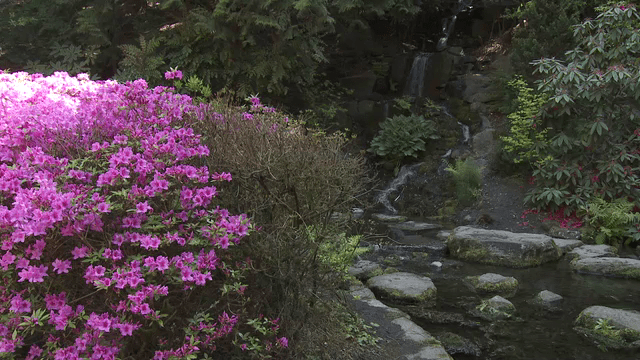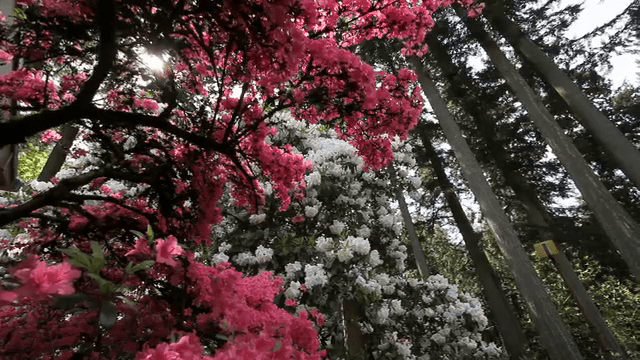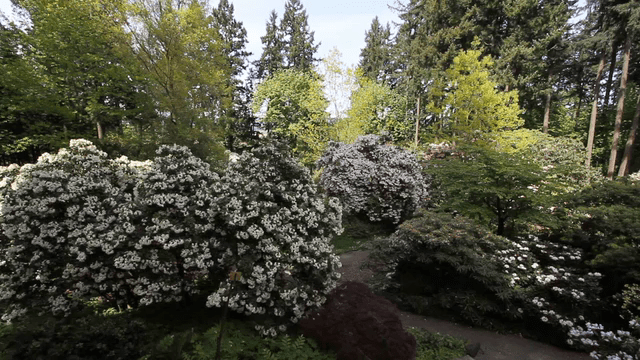It’s nice to know that Mother Nature can treat us to what we enjoy most at this time of year: clear skies and warm sunshine!
That’s especially true in western Oregon as spring hits its stride with amazing colorful shows at three spring getaways for the price of one drive. Join me for a gas tank getaway down where you will slow down and savor bursts of natural color.
Dick Cavender, a member of the American Rhododendron Society, told me that Portland’s Crystal Springs Rhododendron Garden is the city’s best-kept secret. “I am constantly amazed at the number of people I run into who don’t even know that Crystal Springs exists.”
The garden is at its prime right now; it’s where a real riot of color has exploded across the nine-plus acre public garden. Fed by natural springs that you can actually see bubbling up out of the ground, it’s a garden surrounded by water. “We have more than 5,000 plants in this garden and they’re all shades of colors and all sizes. Some of the foliage forms are just unbelievable,” added Cavender.
The Crystal Springs Garden opened in 1950 as the result of a partnership between the city and the Portland Chapter of the American Rhododendron Society. It is a must-see for out of town guests or anyone who calls Portland home. “We have 160 varieties of birds, 80 varieties of trees, all kinds of herbaceous ferns and bulbs – there’s just a huge amount of plant material in this garden,” noted Cavender.
Garden number two is Hendricks Park, Eugene’s oldest city park that sprawls across nearly 80 acres. Within it, 15 acres are dedicated to rhododendrons and azaleas according to Emily Aune, the parkland’s plant specialist. “The local Rhododendron and Camellia Society got approval from the Eugene City Council to plant a rhododendron garden here in the 1950’s. And some of the plants are originals – 50 year old plants,” Aune said.
Aune added that a small army of volunteers provide the labor force to keep the park in tip-top shape, and that many rare and gorgeous specimens are at their finest through May. “We are just about at the height of their bloom this week, and we have a mix of native and horticultural varieties of plants; rhodies, azaleas, camellias that continue blooming for several weeks. There’s a lot variety and diversity.”
Finally – my all-day “Rhodie Round-About” wraps up at garden number three, set in the rural landscape of Marion County near Champoeg State Park. It’s a private garden that is open to the public and its roots are “all in the family.”
The Cecil and Molly Smith Garden was an all-family affair when the first plantings went in the ground more than six decades ago. It was a time when every member of the family pitched in – including brothers Al and Sid Smith. We enjoyed growing up here of course, but it’s become quite magnificent over the years. It’s a legacy from our parents and something to be shared with the public.”
Cecil Smith was a farmer and an avid gardener who collected seeds and pollen from Europe, Japan and even China. His garden was purchased by the Portland Chapter of the American Rhododendron Society in 1983, and it offers more than 500 different plants for you to admire.
The Smith Garden is open to the public on spring weekends. According to Tour Guide Karen Cavender, Cecil was famous for the hybrid rhodies that he created – he gave them to friends who came to visit his gorgeous woodland garden. “Mostly it’s a woodland garden rather than a formal garden. You walk under large towering rhodies and azaleas that are so impressive right now. Cecil very much wanted the plant to look good all year round too.”
Al and Sid Smith agreed that winding trails invite you along and you can’t quite see what’s around the next bend until you get there; it’s a soul-satisfying way to round out a day-long adventure.



